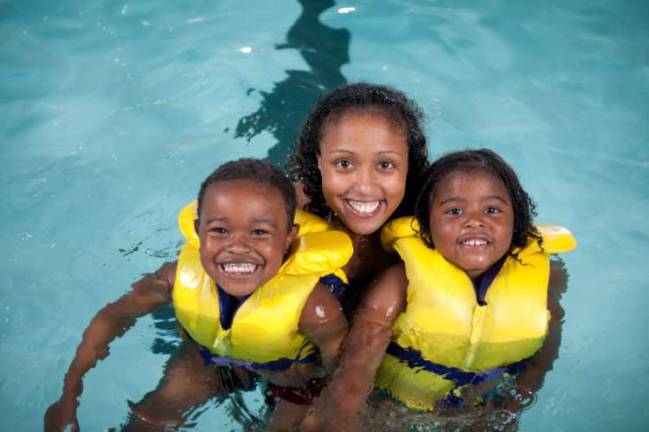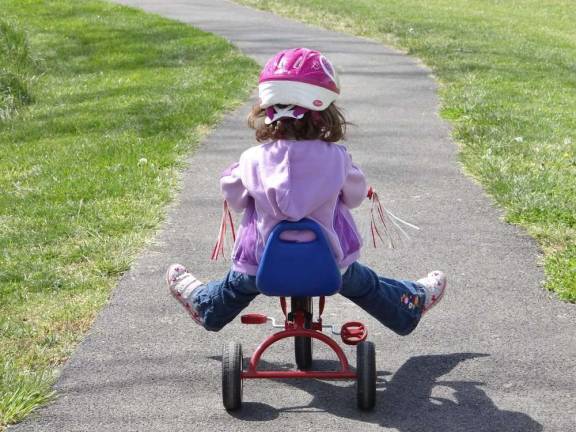Tips for keeping infants and toddlers safe this summer


By Brittany Allen, MD
The sun is shining, the corn is knee-high, and everyone wants be out in the sun before winter rolls back in. As people are planning their summer vacations, many pediatricians are asked about how and when infants or toddlers can participate in their parents’ or siblings’ favorite summer activities, such as biking, swimming, and boating. Being outdoors and active is great for the whole family, but safety – as always – comes first when you’re thinking about having your little one along.
BikingBicycling is a wonderful way to be active and get around in the summer, but many parents are unsure when their infant or toddler can join them for the ride. Most importantly, infants need to able to sit well in an infant bicycle seat or bike trailer for a long period of time and strong enough to control their head while wearing a bicycle helmet that is appropriate for their age. For these reasons, children less than 12 months of age should not be transported by bicycle.
Safety should be fun! Celebrate your child’s birthday with a bicycle helmet and a ride in their bike seat or trailer.
The two primary options available for supporting a toddler for bike travel are mounted seats and bike trailers. Children, including infants, should never be transported in infant carriers or backpacks, as these are not secure, generally do not allow for helmet wear, and can lead to serious injury if an adult or older child lands on an infant during a crash. Bike trailers are generally thought to be the safest option, as they are low to the ground, allow for a child to be securely harnessed while wearing a helmet, and provide structure that can be protective in minor crashes.
Mounted bicycle seats for toddlers also allow for secure harnessing with a helmet in place and can be less bulky than trailers, though their height can add to the momentum of falls. Front-mounted bicycle seats have entered the scene more recently and their safety compared to rear-mounted seats is unclear; front-mounted seats are more limited in their weight requirements, so be sure that the seat is appropriately sized for your child. If you are considering a mounted seat, ensure that the seat is securely and appropriately attached to your bike frame, that the seat has a sturdy harness and high back that can support a sleeping child, and that spoke guards are in place to prevent injury to a child’s feet or hands.
No matter the mode that you choose for including your child in biking, you can make your trip safer by:
Taking less-traveled roads and roads with clearly marked bike lanes
Using hand signals to let drivers know when you’ll be turning
Making sure that your bike is highly visible, with bike lights and visibility flags for trailers
Double-check child seat and trailer attachments before every ride
Taking into account that adding an infant seat or trailer to your bike may add to your brake time and bike instability
Making sure that you and your child always wear a helmet when on a bicycle.
SwimmingNothing says summer like a day at the beach, and many children love the sand and the water. Sometimes, however, crowded areas and unfamiliar undertows can make it difficult to keep your young child safe, and drowning is a leading cause of death for 1-4 year-olds. Knowing your surroundings and committing to appropriate supervision can keep children safe and lead to great play that involves the whole family. For infants and toddlers, “touch supervision” – where an adult is within reach of the child at all times — is recommended whenever a child is in or near the water.
Sing songs and play games in the water with your child while practicing touch supervision.
To ensure that the supervising adult is able to devote full attention, it’s also important to make sure that smart phones or other distractions are put away and to clarify which adults are supervising particular children. Designate one adult as a “water watcher” so that the role is clear. Choosing beaches and pools that have life guards on duty also help to ensure that an individual trained in CPR and rescue is available in case of emergency. For young children, wearing a personal flotation device (PFD, or life jacket) helps to ensure safety when they are playing in or near the water (see Boating section below for more information).
Many parents wonder whether their infant or toddler should take swimming lessons so that they are more comfortable in the water. Swimming lessons can be a fun way to get outside with your child at this age, and should always involve a parent or guardian for children under three. This makes for a great activity that families can share, but does not change the importance of close supervision in water. While a few small studies have suggested that swimming lessons may decrease risk for drowning in this age group, no lesson or intervention can promise to prevent a child from drowning.
Summer safety and drowning prevention is also critical at home, as infants and toddlers can drown in even small amounts of water. Home pools should be appropriately covered and fenced on 4 sides by a fence that is at least 4 feet high. This is true of “inflatable” pools as well. Pop-up pools are popular with families because they’re larger than a kiddie pool, but don’t have the expense of an installed pool. This is a concern not just for the children living in the home, but for other children in the neighborhood. Often, these pools are not fenced, making it possible for young ones to climb in unsupervised. If you have a pop-up pool, put a fence around it. And, if you have a kiddie pool, be sure the empty the pool after use and supervise children closely around yard ponds and other bodies of water.
BoatingChildren can be brought along as passengers on a boat when they are big enough to wear a personal flotation device (PFD, or life jacket) that is appropriate for their weight, approved by the U.S. Coast Guard, and fits well. PFDs for infants and young children should have flotation collars, straps that go between their legs, and handles to ensure that the PFD will stay on and cause an infant to face up and be easily removed from the water if needed. The fit of a PFD can be assessed by having your child raise their arms up over their head in the “touchdown” sign: if the PFD bumps into the child’s ears or chin, it is too loose. Water wings do not provide appropriate flotation, do not cause the wearer to float on their back, and should never be used to replace a PFD.
For fun, let your child get used to their PFD by wearing it on land and pretending to boat. Older children can be designated “safety captains” and can be in charge of verifying that every passenger has a PFD before the boat leaves the dock.
Boats, like homes, should be childproofed and have limits and rules for safety. Consider what your child can access from their position in the boat and set limits around unsafe activities, such as running or putting hands or feet outside of the boat. Adults operating a boat should have the appropriate license and should never operate a boat after consuming alcohol or other drugs.
When out on the water, it’s also important to consider the risks from exposure that can occur. Small children are at higher risk for hypothermia than adults; plan ahead with extra changes of dry clothes, layers, and towels to help dry a wet child off. Lightweight clothing can also be good protection against the sun, but don’t forget to bring sunscreen (at least SPF30) and reapply frequently when you are out on the water.
Getting outside and being active is fun and an important part of your family’s health. Use these tips to help you safely include your infant or toddler in biking, swimming and boating so that the whole family can have fun in the sun.
Source: "Growing Up Healthy," a blog from American Family Children’s Hospital, University of Wisconsin-Madison: uwhealth.org